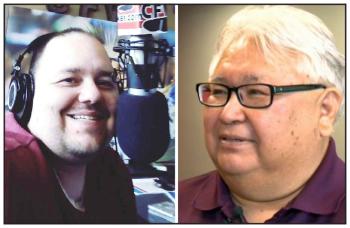Image Caption
Windspeaker.com
The Windspeaker Radio Network is expanding the number of sports games it will broadcast in an Indigenous language this spring and summer.
Network officials have confirmed details for four upcoming matches that will be broadcast.
For starters, for the first time, the network will broadcast an Edmonton Riverhawks’ baseball game. That contest on June 7 will be on 89.3 The Raven. Portions of the broadcast will be in Cree.
The Riverhawks compete in the summer collegiate West Coast League, which includes teams in British Columbia, Oregon and Washington.
The Raven will then broadcast, with segments in Cree again, an Edmonton Stingers’ basketball game on July 1.
The Stingers, a professional franchise, are members of the Canadian Elite Basketball League. This will mark the second year Windspeaker Radio Network has covered a Stingers’ game.
The network will also broadcast a pair of Canadian Football League contests this summer.
First up will be the broadcast of the Edmonton Elks’ home tilt on July 28, which will be partly in Cree on CFWE FM.
This is the third consecutive year Windspeaker Radio Network has broadcast an Elks’ home game.
And for the first time, the network will broadcast a Calgary Stampeders’ home match. That game, which will include broadcasting in the Blackfoot language, will be on Sept. 14 on CJWE.
Bert Crowfoot, Windspeaker Media’s CEO and president, said his network’s first foray into Indigenous language broadcasting had mixed results three years ago.
The network broadcast an Elks’ game entirely in Cree in 2022.
“For a lot of people, it’s interesting listening to it,” Crowfoot said. “But, if you don’t understand it, you tune out after a while. And you’ll go to mainstream radio because you just don’t understand what they’re saying.”
Crowfoot said the decision was made last year to also include English-speaking commentary during the network’s Indigenous language sports broadcasts.
“We had a Blackfoot speaker, we had a Cree speaker and we had an English speaker,” Crowfoot said of the 2023 CFL game broadcast from Edmonton. “It was pretty interesting. It worked out pretty good. At least I thought so.”
Wayne Jackson, who is Cree and a member of Goodfish Lake First Nation in northeastern Alberta, will provide the play-by-play coverage of the three games Windspeaker Radio Network will broadcast from Edmonton this year.
Jacob Leblanc will provide analysis of all the games in English.
Leblanc will also be part of the broadcast team for the Stampeders’ match. Butch Wolfleg, a member of Siksika Nation in southern Alberta, will provide the Blackfoot commentary for the game.
Jeremy Harpe, Windspeaker Radio Network’s director of radio, said previous games broadcast in Indigenous languages have been well received.
“I know during the game not only do we get a lot of texts at our station textline, but our on-air hosts, especially Wayne Jackson, who is taking care of the Cree, his phone is flooded with comments from listeners that he knows personally saying ‘This is pretty darn cool,’” Harpe said.
Those who broadcast the games for Windspeaker also get a big kick doing so, Harpe said.
“They’re like little kids when they go to the stadiums,” he said. “They get to mingle with the TSN crew. And they get to commentate on a CFL game. So, there’s a lot of excitement with the crew. Bert and I are pretty giddy during the games, too.”
Crowfoot said Windspeaker Radio began doing language programming half a dozen years ago with a show titled “The Voices of Our People”.
Crowfoot said one woman told him she sat in her car with her daughter in the parking lot of a department store listening to a broadcast.
“They were so infatuated with the topic that this lady Elder was talking about and they could understand,” Crowfoot said. “They actually sat in their car for 15 minutes until the interview ended and then they went shopping.
“She made a point of getting a hold of us to tell us how interesting and how thankful she was that we were able to share that with her. So, that’s when we kind of knew that the bilingual approach worked because if people start listening, they might not understand the language part but they’ll understand the English part.”

